Freemium or Free Trial - which business model to choose when selling software?

The monetization model is precisely the fad in the strategy of each project, both a cloud service and an offline business, which ultimately determines its success. The correct model of monetization - a kind of key to the apartment, where the money is. If he does not fit, then this startup is unlikely to turn into a real business. For cloud services recently, various variations of free versions or trial period are popular. In this regard, we want to share the article by Lincoln Murphy, which can help find the right "key" to a successful business, and answer the questions about whether it is better - freemium or a free trial period - free trial. The article is written in the first person.
To the question which model is better to use for the cloud service - Freemium or Free Trial - I answer all the time. (For those who doubt that their potential customers, if they have a free version, want to pay at all, we recommend reading the article “Why shouldn't software be free?” )) Companies of all stripes and sizes ask me about this, and very young startups, and established organizations that are thinking of switching to another system of work or adding new opportunities, and Internet companies reflecting on their development strategies.
It seemed to me that I told so much about all this that the answer is obvious. However, no. Therefore, I decided to tell about it in such a way that I could later point the finger at this post if I was again asked: “Freemium or Free Trial?”
')
In fact, the question itself is wrong.
Here is a letter I recently received:
“Hello, Lincoln! We in our startup have grown to the decisive moment when it is necessary to choose a monetization model - Freemium or Free Trial. And stuck on it. So many pros and cons of each option. Will you help? ”
My answer:
“It's not about Freemium or Free Trial, and in general these are incorrect options. It is necessary to choose between a Freemium or Premium-class product. More correctly ask the question which one is better suited for your company.
If you stop at a premium product, then you can try offering to try it for free for a certain period, Free Trial. But to do this is not necessary.
It’s not just a matter of terminology, and I’m not trying to make an elephant out of a fly. ”
Each of these models has one problem - how to get paid customers in the end? This problem is vividly displayed by the scheme:
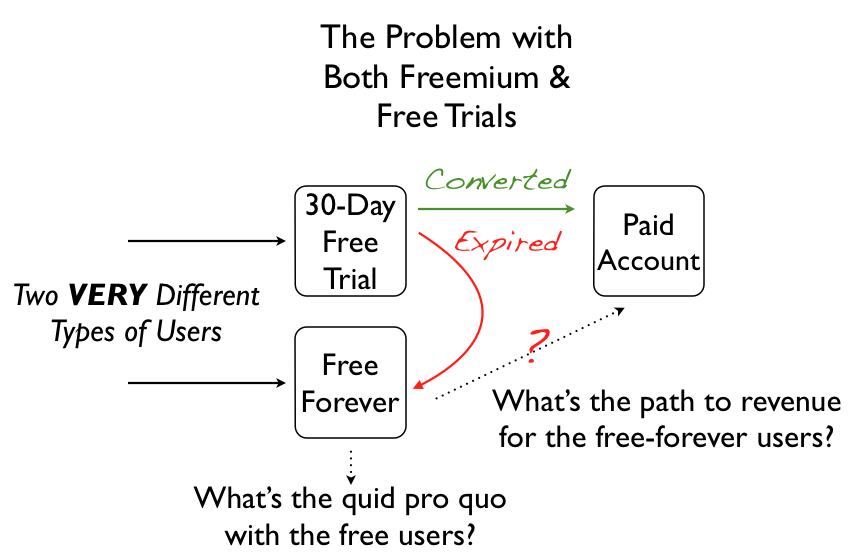
A source
From the diagram it is clear that it is most difficult to understand what the benefits of the service are from users of the free application, and how to turn them into paying. With the trial period, everything is more or less clear: by the end of it, users either convert to paying customers or not.
Let's dive into the problem.
What is freemium?
Freemium is a marketing model that generally should be viewed as a business model whereby you provide access to some or all of your products for free forever, without any time limit.
There may be other restrictions - on available options or use volumes - but there is no time limit, the product is always free.
What you offer on the terms of Freemium, should initially be designed with high quality, and the design worked out. To use Freemium as an addition to something already prepared is meaningless, it will definitely not lead to success. However, “success” in relation to Freemium is a relative concept, it is very difficult for it to define.
The Freemium model is expedient and has the greatest chances of success if the market is huge and the people to whom you always offer your product for free will add value (which will constantly grow) - for you, for other users and for paying customers . When you are thinking about Freemium, you should take into account these circumstances and keep in mind that the result should be beneficial to all - both to you, and users of the free version, and paying customers.
But how will these more than 97% of people who most likely never pay you a penny be useful to you? Will create content? Build up volumes? Virality? Something else?
If they do not add value to the project - you just do charity work. Charity is good, but not for profit-oriented business. And you will need to think through every aspect of your activity in order to be sure that users of the free version will certainly bring something to the product. One cannot hope that they will come to their senses themselves.
And if we do not discard -media?
No, of course, if you go to create a huge customer base and sell it for billions, like Instagram ... then cool. Only I would not do any Freemium, I would do just Free, free of charge, that is, for nothing, and did not worry about profits. You see, the most difficult thing with Freemium (assuming that everything else — market, product, experience, etc. — is fantastic) is not to get users, but to generate profit.
And the main reason for this is the psychological barrier.
Remember: when you catch someone with a bait “we will always be free,” then it’s almost impossible to make that person pay for access. That's why successful cloud services have a conversion rate of around 3%. It's all about psychology.
I already wrote about some companies that have successfully switched from Freemium to an exclusive premium product (but, as a rule, with a free trial period). When you catch a user for "free", it is impossible to manage his expectations. This can be prevented by constantly offering a premium version and talking about its benefits to users free of charge. I always give such advice to freemium companies, but this is only necessary to do from the very beginning, otherwise you will “hook” users for “freebies”.
From this, the now outdated principle “penny gap”, a penny surcharge, has grown: it is very difficult to make a person pay at least a penny for what he now has for free.
Therefore, there is already ...
Different Freemium options
Over the past few years, the Freemium model has moved away from its classic variation, i.e. when at some point it is proposed to pay for what you already have. Today we can meet a wide variety of Freemium options.
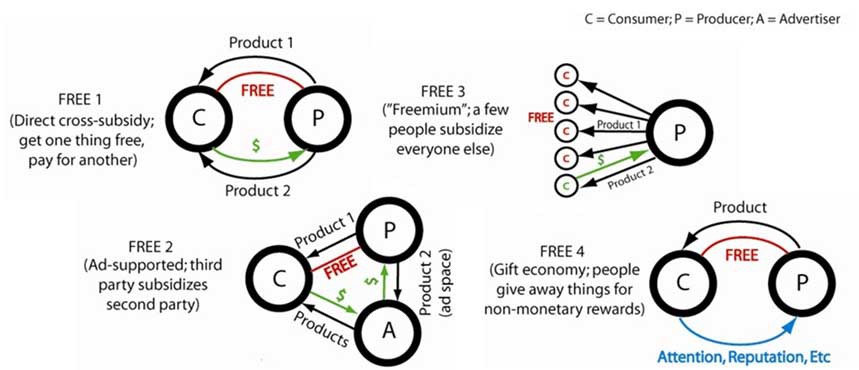
A source
In the diagram above - several options for freemium-model. The first option is that the client receives one product for free if it pays for another. An example is in the USA if you enter into a contract with a mobile operator, you can get a phone for free. The second option is a free product, and the service exists due to advertising. This is a model of most social networks, for example. The third option - the company provides many products for free, but it earns on premium products, and there is due to income from them. Example - Skype, which allows a huge number of people to use their product, and its service covers the income from not so many users of premium products. The fourth option, when each user brings something to the service for nothing, this is how Wikipedia works.
Fees may be charged for plug-ins, extensions, additional functionality, support, integration, personalization, etc. — and not just for “more” —in fact, almost the same thing you used before for free. This is a bit like the model that B2C games use. For example, Candy Crush Saga is a freemium game that currently generates about 950 thousand dollars a day. IN A DAY. Are you still excited about your business idea?
Anyway, the model used in games like Candy Crush is the sale within the application of all virtual goods, additional levels, accelerated gameplay, etc. It is obvious that Candy Crush was originally created in order to cause "addiction", and has all the necessary psychological elements. People are underway, real sales of virtual goods and services are growing.
This raises an important issue.
Need to develop new habits
Gradually, I began to realize that for the success of the Freemium model in B2B applications, something else is needed, and this “something” is a habit. At the same time, it is necessary to develop such a need for the application to be used many times a day.
I won't say that this is necessary for all cloud services of the B2B segment, for some metrics of daily activity, i.e. the number of active customers per day (DAU) - does not play a big role. But for the success of a B2B application with the Freemium model, I think it is critical. This becomes even more obvious if we return to the principle of mutual benefit, when every free user should be at least something useful. In this case, we can assume that those who use the application several times a day are more likely to make a profit (as well as new users and customers) than those who open it once a week. So, if your SaaS application has no chance of becoming a habit, there is nothing to deceive yourself, it will be extremely difficult to change people's behavior, and the Freemium model is probably not for you.
The fact that there are SaaS companies that inactive customers pay (at least until they understand what is happening and refuse) proves that the mere fact of paying for a product is not enough motivation to start using it is just as difficult to get to switch on a paid model, if the price is quite substantial.
Whatever model you decide to do — freemium or not — you must minimize the entry barrier and doubts and lead your users to realize (at least think about it) the value of your product for them. This means that registration to get a trial version should be simple and quick, or even it may not be at all (as in Optimzely, Gliffy or Codecademy).
Gliffy implemented this feature with a cool call to action button - “Start drawing.”

Optimizely just requires you to enter the site's URl in the empty field to see how the service works.
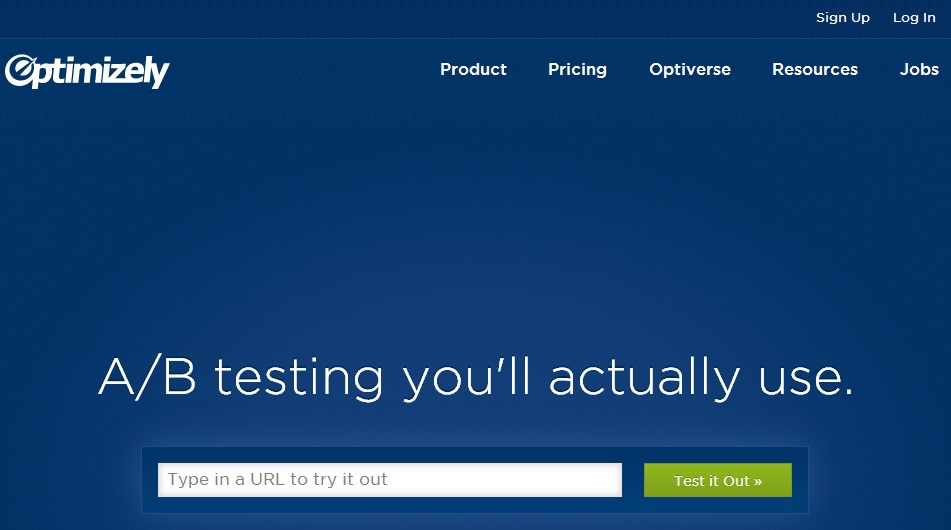
Codeacademy arrived even simpler: in their service, you can log in via social networks.
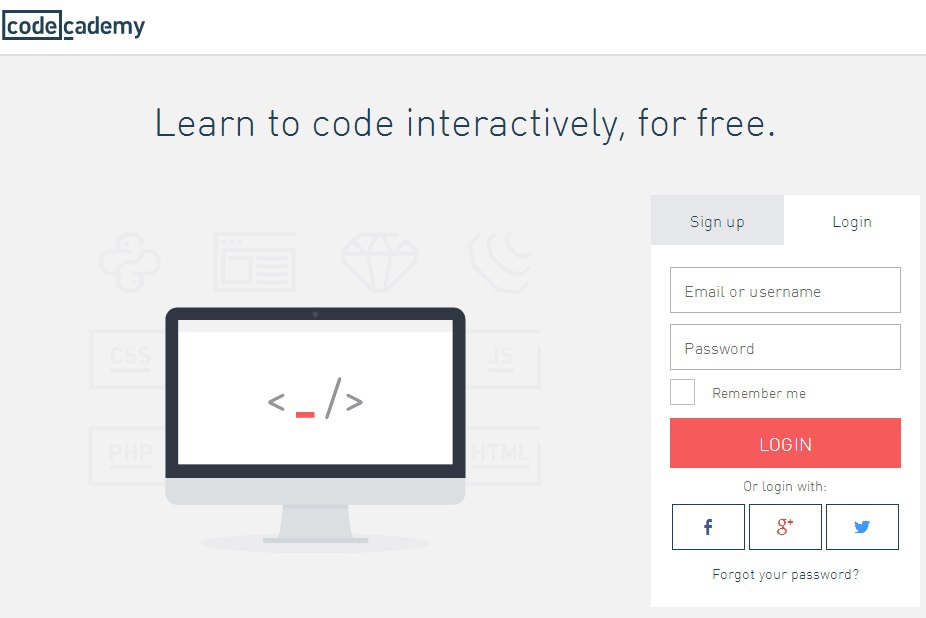
In any case, you will have to understand ...
What do you want to replace with your product?
Let's go back to the games for a second. If you have already played Clash of Clans to start playing Candy Crush, you will not have to pay anything. Just install it (possibly through an advertisement inside Clash of Clans) - and more. Now you have two games.
From a business point of view, the games are awesome. Because the user does not need to choose between them: he can have this game And that game, And one more game. But this is unlikely to work in the case of CRM: you do not need another CRM for this CRM either, one is enough for you.
It is much easier to force the user to try a new game (and try to plant it quickly) than a B2B application. Games are established under the influence of momentum, there are no payment procedures, agreements, marketing research, painful transition, recovery, and so on. The user does not bear the costs. SaaS-service from the category of products to choose from (when you need only one) is more difficult to sell.
As I said, people and companies use only one CRM, only one HR application, only one cash register system, and so on. Of course, in different units can use several SaaS-solutions for similar tasks, but each of them uses only one.
In general, you should know what place you will occupy in the familiar world of your client, whom and what you oust if they choose your solution: competitors, self-made solutions, free resources or ... nothing (which, in fact, should cause concern) .
The more solutions you replace, the more valuable your product can be. But the more expensive the transition to your decision is and the less likely it is that the use of your product will become a habit, the more likely it is that the Freemium model will not work for you.
Whichever model you use, whether freemium or not, you must understand what you are offering instead of it, and how it will work with your application, in parallel with the old customary solutions or putting them aside. Understand it is not easy.
If you are not replacing anyone, i.e. your potential customers are not currently engaged in what your product provides; know that you are opening a new market niche. It can be very profitable, but it is guaranteed to require a lot of effort, time and money. Although, it is possible that this is an ideal option for Freemium.
Just a minute ... I forgot about something else
I did not say this before, I was distracted.
People nowadays are so scattered, they are so easily distracted!
You can, of course, assume that the reason for our absent-mindedness in ourselves (for example, I can try to go through the 70th level of Candy Crush, at the same time making changes to the client’s profile, sending mail and reading Twitter), but this is not the point.
We all suffer from a lack of time and resources. And we need to understand that, by offering our application, we are invading the world of a scattered person, whose brain is already overloaded with information. And we have to work with it, take it into account, fight it. And do not forget about it.
How about a free trial, Free Trial?
More precisely, what about the Premium + Free Trial combination?
Firstly, everything I said about the cost of the transition, lack of resources, habits, etc., applies to Free Trial. Refers, but does not cause such problems, as in the case of Freemium (if your product meets customer expectations), because it is what it is called: a free trial version of a paid solution (commercial, premium, very valuable).
Freemium is given free and forever, and Free Trial is given for a specific time. And when time runs out, there are two ways: pay or refuse.
Although there are companies that manage to combine both models in their tariff plan, for example, Twigmo.

A source
Therefore, if your application does not satisfy the “requirements” I described for successful Freemium, then you can go a more traditional way and not use it. For example, it is aimed at a small market, or free users cannot bring enough profit (they will not be scattered around the world, and the network effect will be minimal), or it is very difficult to turn the use of this product into a habit. This means that you have a worthwhile offer, which, as you think, can bring real money and become the basis of a small business for $ 100 million. Then ask for a fee for it from the very beginning, and then offer a free trial version of this paid product.
I'm talking about a free trial, because I think this is the best way. If you are planning to take at least $ 1 for a trial version or even just ask for credit card details for the future, there are no guarantees that you will be able to attract customers with this method.
From my own experience I can say that the offer just Free Trial - a free trial version - already increases sales. But if this version is poorly developed, it is difficult to get used to it, it is difficult to implement, it doesn’t convert customers well, it will hit the cost of attracting a single client.
There are thousands of tips on how to organize the Free Trial most effectively, and in addition, the free test versions are a simpler approach, devoid of Freemium-related psychology.
However, there are companies that refuse to even provide a free trial period, and immediately require money from customers, for example, Assis.
Old fare selection page, where there is a free trial period
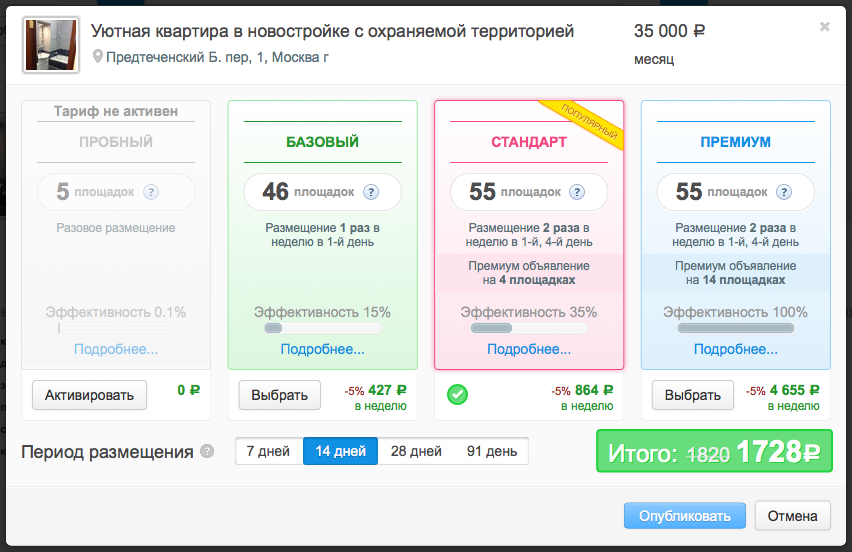
New tariffs, exclusively paid
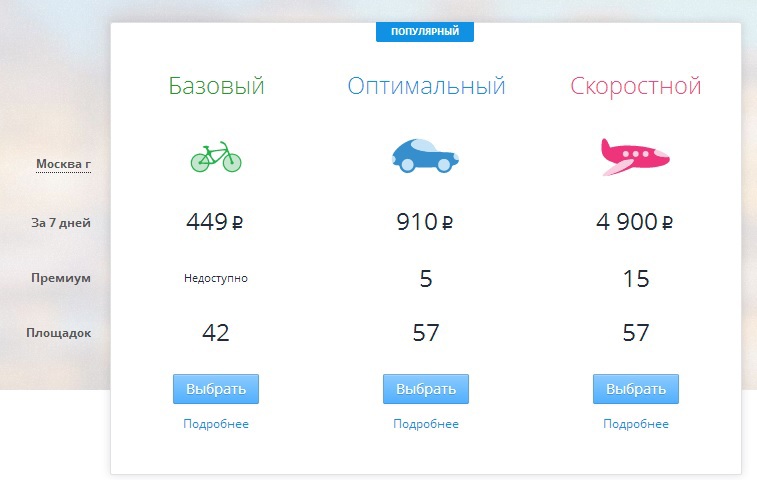
A source
So what's better?
I can't decide for you. Giving advice is nice, but this problem requires the attention of your domestic entrepreneur. Because in the end it is likely to be an intuitive solution, even if you have shoveled mountains of market statistics.
The reality is that if your target market is not sufficiently branched out and potential customers do not communicate with each other (i.e., it is difficult to get them to tell each other even about an interesting article, not like a useful B2B application), then you may not be able to work on it quickly so that the Freemium model works efficiently.
On the other hand, if this is a new idea for your market, it is not a fact that it will not work.
I urge you to go back to basics and think things over carefully. And then, I hope, you will make the right decision and take over the world!
Source: http://sixteenventures.com/freemium-or-free-trial
Source: https://habr.com/ru/post/234579/
All Articles